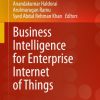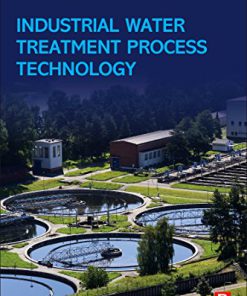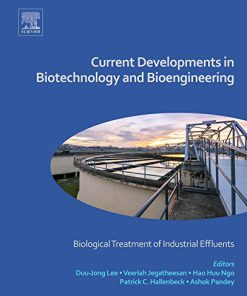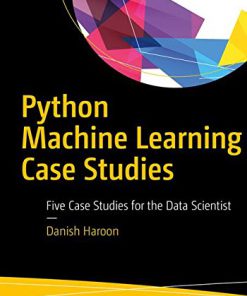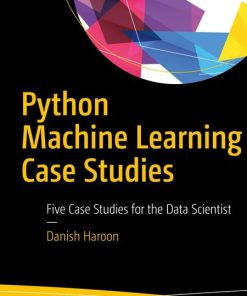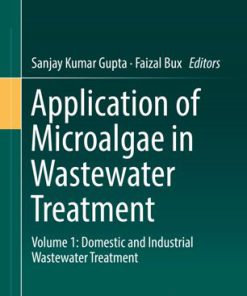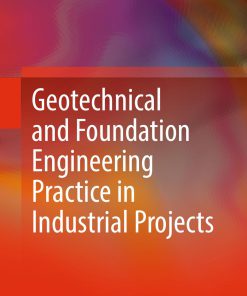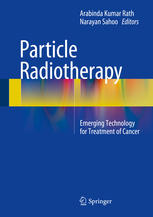Treatment of Industrial Effluents Case Studies 1st Edition by Mihir Kumar Purkait, Piyal Mondal, Chang-Tang Chang 0429686818 9780429686818
$50.00 Original price was: $50.00.$25.00Current price is: $25.00.
Treatment of Industrial Effluents Case Studies 1st Edition by Mihir Kumar Purkait, Piyal Mondal, Chang-Tang Chang – Ebook PDF Instant Download/DeliveryISBN: 0429686818, 9780429686818
Full download Treatment of Industrial Effluents Case Studies 1st Edition after payment.
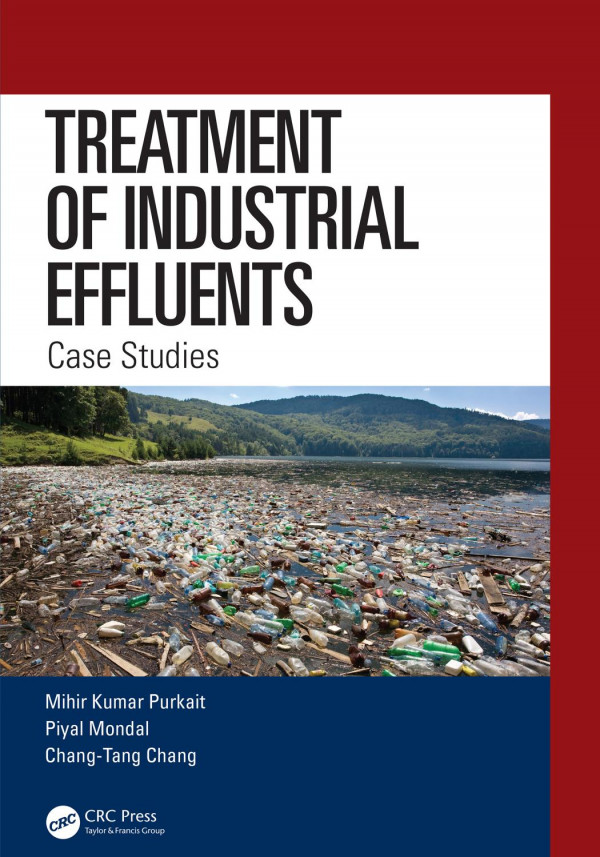
Product details:
ISBN-10 : 0429686818
ISBN-13 : 9780429686818
Author: Mihir Kumar Purkait, Piyal Mondal, Chang-Tang Chang
To address the issue of discharge of untreated industrial effluent in the water body causing pollution, adoption of cleaner production technologies and waste minimization initiatives are being encouraged. The book explains each related technology elaborately and critically analyses the same from practical application point of view. In-depth characterization, environmental and health effects and treatment of various industrial effluents are discussed with case studies. Limitations, challenges and remedial actions to be taken are included at the end of each chapter. Chapters are arranged as per specific type of effluents from various industries like textile, tannery/leather plant, and oil refinery.
Treatment of Industrial Effluents Case Studies 1st Table of contents:
1. Introduction to Different Industrial Effluents and Existing Treatment Technologies
1.1 Overview about Industrial Effluents
1.2 Different Industrial Sectors and Its Importance
1.3 Need for Treatment of Industrial Effluents
1.4 Classification of Treatment Technologies
1.4.1 Traditional Methods
1.4.2 Hybrid Methods
1.5 Salient Features of Different Treatment Technologies
1.5.1 Biodegradability
1.5.2 Dewaterability
1.5.3 Renewable Energy Production
1.5.3.1 Biogas Production
1.5.3.2 Biohydrogen Production
1.5.3.3 Bioethanol Production
1.6 Treatment and Types of Industrial Effluents
1.6.1 Treatment of Paper and Pulp Effluents
1.6.2 Treatment of Wastewater from Coal Combustion
1.6.3 Treatments of Petrochemical Effluents
1.6.4 Treatments of Textile Industrial Effluents
1.6.5 Treatments of Pharmaceutical Industry Effluents
1.7 Future Scope
1.8 Summary
References
2. Treatment Techniques of Textile Plant Effluents
2.1 Overview of Textile Plant Effluents
2.2 Main Composition of Textile Plant Effluents
2.3 Hazardous Effects Associated with Untreated Textile Plant Effluents
2.4 Techniques Utilized for the Treatment of Textile Plant Effluents
2.5 NF Membrane Technology in Dye Removal Process
2.6 Case Study
2.6.1 Experimental Section
2.6.1.1 Material Used and Overview of Effluent Properties
2.6.1.2 System Configuration Used for the Treatment Process
2.6.1.3 Operating Conditions
2.6.2 Analysis of the Samples
2.6.2.1 Measurement of Dye Concentration
2.6.2.2 Measurement of COD
2.6.2.3 Measurement of Conductivity, TS, and pH Measurement
2.6.3 Results and Discussion
2.7 Future Scope and Limitations
2.8 Summary
References
3. Treatment of Leather Plant Effluents
3.1 Introduction
3.2 Generation of Wastewater from Leather Industry
3.2.1 Leather Production and Chemicals Used
3.2.2 Wastewater Generation and Characterization
3.2.3 Biodegradation Characteristics
3.3 Techniques Utilized for the Treatment of Leather Plant Effluents
3.3.1 Coagulation and Flocculation
3.3.2 Biological Treatment
3.3.2.1 Aerobic Process
3.3.2.2 Anaerobic Process
3.3.2.3 Wetlands and Ponds
3.4 Emerging Treatment Technologies
3.4.1 Membrane Processes
3.4.2 Application of Membranes in Leather Tanning Operations
3.4.3 Membrane Bioreactors
3.4.4 Advanced Oxidation Process
3.4.4.1 Fenton-Based Processes
3.4.4.2 Photooxidation Processes
3.4.4.3 Ozone-Based Processes
3.4.4.4 Photocatalysis
3.4.4.5 Electrochemical Treatment
3.5 Case Study
3.5.1 Case Study 1
3.5.2 Case Study 2
3.6 Future Scope and Limitations
3.7 Summary
References
4. Treatment of Palm Oil Mill Effluents
4.1 Overview of Palm Oil Industry
4.2 Oil Processing and Effluent Generation
4.2.1 Oil Processing
4.2.1.1 FFB and Transfer
4.2.1.2 FFB Sterilization
4.2.1.3 Threshing, Digesting, and Screw Pressing
4.2.1.4 Depericarping
4.2.1.5 Clarification of CPO
4.2.1.6 Kernel Separation and Drying
4.2.2 Waste Generation
4.3 General Characteristics of POME
4.4 Conventional POME Treatment Technologies
4.5 Alternative POME Treatment Technologies
4.5.1 Coagulation/Flocculation Treatment
4.5.2 Adsorption Treatment
4.5.3 Advance Oxidation Process
4.5.4 Membrane Treatment
4.5.5 Photocatalytic Degradation
4.6 Case Study
4.6.1 Case Study 1
4.6.1.1 Experimental Materials and Procedure
4.6.1.2 Results and Discussion
4.6.2 Case Study 2
4.7 Future Scope and Limitations
4.8 Summary
References
5. Treatment of Effluents from Sugar Processing Industry
5.1 Overview of Sugarcane Industry
5.1.1 Procurement of Sugarcane
5.1.2 Milling of Sugarcane
5.1.3 Juice Preparation
5.1.4 Juice Concentration
5.1.5 Syrup Processing and Crystallization
5.1.6 Sugar Crystal Separation, Drying, Packing, and Molasses Handling
5.1.7 Bagasse Utilization
5.2 Processing of Wastewater: Sources and Characteristics
5.3 Treatment Methods of Effluent
5.3.1 Biological Methods
5.3.1.1 Anaerobic Treatment
5.3.1.2 Aerobic Treatment
5.3.2 Physicochemical Methods
5.3.3 Membrane Treatment
5.3.4 Electrodialysis
5.4 Treated Effluent Quality: Reuse and Recommendations
5.5 Case Study
5.6 Summary
References
6. Treatment of Pharmaceutical Industry Effluents
6.1 Introduction
6.2 Pharmaceutical Process Wastewater
6.2.1 Fate of APIs, Pharmaceuticals, and Drugs to the Environment
6.2.2 Health Hazard of Discharged Pharmaceuticals
6.3 Effluent Treatment Options
6.4 Overview of Pharmaceutical Manufacturing Processes and Effluent Compositions
6.4.1 Profile of the Pharmaceutical Industry
6.5 Pharmaceutical Manufacturing Processes
6.5.1 Chemical Synthesis Process
6.5.2 Fermentation Process
6.5.3 Natural/Biological Extraction Process
6.5.4 Compounding/Formulation Process
6.6 Water Consumption in Pharmaceutical Manufacturing Process
6.7 Solvent Use and Water Requirement
6.8 Treatment of Pharmaceutical Effluent
6.9 Recovery Processes
6.10 Effluent Treatment of Dilute Streams
6.10.1 Biological Treatment
6.10.1.1 Aerobic Treatment
6.10.1.2 Membrane Bioreactors
6.10.1.3 Anaerobic Treatment
6.10.2 Advanced Treatment Process
6.10.2.1 Membrane Technology
6.10.2.2 Activated Carbon
6.10.2.3 Membrane Distillation
6.10.3 Advanced Treatment Processes (Advanced Oxidation Processes)
6.10.4 Ozone/Hydrogen Peroxide Treatment
6.10.5 Fenton’s Oxidation Treatment
6.10.6 Photocatalysis
6.10.7 Electrochemical Oxidation/Degradation
6.10.8 Ultrasound Irradiation
6.10.9 Wet Air Oxidation
6.11 Hybrid Technologies
6.11.1 Hybrid Technologies for Chemical Synthesis Process
6.11.2 Hybrid Technologies for Fermentation Process Effluent
6.12 Case Study
6.13 Future Scope and Recommendations
6.14 Summary
References
7. Treatment of Paper and Pulp Industry Effluents
7.1 Introduction
7.2 Manufacturing Process and Wastewater Generation
7.2.1 Tannins
7.2.2 Resin Acids
7.2.2.1 Anaerobic Treatment of Resin Acids
7.2.2.2 Aerobic Degradation of Resin Acids
7.2.2.3 Comparison between Anaerobic and Aerobic-Degradation of Resin Acids
7.2.2.4 Microbiological Degradation of Resin Acids
7.2.3 Fatty Acids
7.2.4 Halogenated Compounds
7.2.4.1 Degradation of Organochlorides
7.2.4.2 Aerobic Degradation of Organochlorides
7.2.4.3 Anaerobic Degradation of Organochlorides
7.2.4.4 Abiotic Degradation of Organochlorides
7.2.5 Color
7.2.5.1 Physical and Chemical Methods
7.2.5.2 Bacterial Cultures
7.2.5.3 Algal Cultures
7.2.5.4 Fungi
7.3 Treatment of Pulp and Paper Mill Effluents
7.3.1 Innovations in the Pulping Stage
7.3.1.1 Modification of Cooking Time or Temperature
7.3.1.2 Extended Cooking
7.3.1.3 Oxygen Delignification
7.3.1.4 Ozone Delignification
7.3.1.5 Biopulping
7.3.2 Innovations in the Bleaching Stage
7.3.2.1 Elemental Chlorine-Free Bleaching
7.3.2.2 Totally Chlorine-Free Bleaching
7.3.2.3 Enzymatic Bleaching
7.3.2.4 Totally Effluent-Free Processes
7.4 Case Study
7.5 Summary
References
8. Effluent Treatment of Semiconductor Industry
8.1 Introduction
8.2 Semiconductor Industry: Wastewater Generation and Its Features
8.3 Semiconductor Industry Effluent Characteristics
8.4 Hazardous Effects of Semiconductor Industry Effluents
8.4.1 Ecological Effects
8.5 Effluent Treatment Techniques
8.6 Case Study
8.6.1 Material and Methods
8.6.2 Wastewater Characteristics
8.6.3 Results and Discussion
8.7 Scope and Future Perspective
8.8 Summary
References
9. Treatment of Livestock Waste and Effluents
9.1 Introduction
9.2 The Future of Animal Production and Wastewater Generation
9.2.1 Global Production, General Trends, and Perspectives
9.2.2 Major Nutrient Flows
9.3 Environmental Impact of Livestock Waste
9.3.1 Soil Pollution
9.3.2 Water Pollution
9.3.3 Air Pollution
9.3.3.1 Emissions of Ammonia
9.3.3.2 Methane and Nitrous Oxide Emissions and Climatic Change
9.3.3.3 Dust and Other Particles
9.3.4 Disease Risks and Health Issues
9.4 Treatment Systems for Livestock Wastes and Effluent
9.4.1 Technological Options
9.4.2 Adaptation of Natural Environments: Soil Filter Systems and Constructed Wetlands
9.5 Case Study
9.5.1 Experimental Methods
9.5.2 Results and Discussion
9.5.2.1 UASB Treatment
9.5.2.2 EC Process
9.6 Future Scope and Limitations
9.7 Summary
References
10. Iron and Steel Industry Effluent Treatment Techniques
10.1 Introduction
10.2 Iron and Steel Industry: Overview of Operations, Effluent Production, and Composition
10.3 Environmental Impacts
10.4 Conventional Effluent Treatment Methodologies in Iron and Steel Industry
10.4.1 Physicochemical Processes
10.4.1.1 Coagulation–Flocculation
10.4.1.2 Adsorption
10.4.1.3 Advanced Oxidation Processes
10.4.1.4 Electrochemical Methods
10.4.2 Membrane Treatment
10.4.3 Biological Treatments
10.4.3.1 Suspended Growth Process
10.4.3.2 Attached Growth Process
10.5 Membrane Bioreactor
10.6 Bioremediation
10.7 Economic Evaluation and Technological Advances
10.8 Case Study
10.8.1 Experimental Methods
10.8.2 Results and Discussion
10.9 Summary
References
11. Treatment of Coal Industry Effluents
11.1 Introduction
11.2 Impact of Industrial Effluents on Living Organisms
11.3 Coke Oven and Waste Generation
11.3.1 Treatment of Coke Oven Waste
11.3.2 Treatment of Coal Washery Waste
11.4 Wastewater Generated from TPPs
11.5 Basic Process of Wastewater Treatment in Coal Chemical Industry
11.6 Treatment Process of Effluent
11.6.1 Biotechnological Approach for Treatment of Wastewater
11.6.2 The Third Wastewater Treatment Processes
11.6.3 Sludge Treatment Process
11.6.4 Waste Gas Treatment Process
11.7 Wastewater Reuse and Treatment Process
11.7.1 Standard Treatment or Concentration Treatment of Concentrated Brine
11.7.2 Evaporation Crystallization Process
11.7.3 Recovery of Phenol Ammonia from Lurgi and Wastewater Treatment
11.8 Case Study
11.8.1 Experimental Methods
11.8.2 Results and Discussions
11.9 Future Scope and Recommendation
11.10 Summary
11.10.1 Strengthening Sewage Treatment Technology
11.10.2 Bioaugmentation
11.10.3 Intensified Posttreatment
References
12. Treatment of Petrochemical Industry Effluents
12.1 Introduction
12.2 Petroleum Plant and Its Effluent
12.3 Petroleum Effluent Generation in Refineries
12.4 Petroleum Plant Effluent Characteristics
12.5 Current Petroleum Effluent Treatment Techniques
12.5.1 Physical Treatment
12.5.2 Membrane Process
12.5.3 Coagulation/Flocculation
12.5.4 Electrocoagulation
12.5.5 Adsorption
12.5.6 Physical–Chemical Treatment
12.5.7 Chemical Treatment
12.5.8 Biological Treatment
12.5.8.1 Aerobic Biological Processes
12.5.8.2 Anaerobic Biological Process
12.5.9 Aerated Lagoons
12.5.10 The Activated Sludge Process
12.5.11 Biofilm-Based Reactor
12.6 Case Study
12.6.1 Experimental Methods
12.6.2 Results and Discussion
12.7 Summary
References
13. Treatment of Nuclear Industry Effluents
13.1 Introduction
13.2 Conventional Treatment Techniques of Effluent
13.2.1 Pyrometallurgical Processes
13.2.2 Hydrometallurgy
13.2.3 Liquid–Liquid Extraction
13.2.4 Chemical Precipitation
13.2.5 Evaporation
13.2.6 Extraction Chromatography
13.2.7 Ion Exchange/Sorption
13.3 Miscellaneous Methods for Effluent Treatment
13.4 Advances in Conventional Treatment of Effluent
13.5 Emerged Technological Options for Effluent Treatment
13.6 Case Study
13.6.1 Materials and Experimental Setup
13.6.2 Results and Discussion
13.7 Risk Assessment and Development of Future Strategies
13.8 Future Scope
13.9 Summary
References
14. Food Industry Effluent Treatment Techniques
14.1 Overview of Food Industry
14.2 Food Industry Effluent Characterization
14.2.1 pH
14.2.2 Alkalinity
14.2.3 Solids
14.2.4 Organic Matter Concentration
14.2.5 Oil and Grease
14.2.6 Nutrients
14.2.7 Surfactants
14.2.8 Color Turbidity
14.2.9 Salinity
14.3 Food Industry Processes and Operations
14.3.1 Preliminary Treatment
14.3.2 Primary Treatment
14.3.3 Secondary Treatment
14.3.3.1 Lagoons
14.3.3.2 Anaerobic Conventional Fixed-Bed Reactors
14.3.3.3 Granular Anaerobic Reactors
14.3.3.4 Horizontal-Flow Anaerobic Immobilized Biomass Reactor
14.3.3.5 Anaerobic Sequencing Batch Reactors
14.3.3.6 Two-Phase Process
14.3.3.7 Aerobic Reactors
14.3.4 Tertiary Treatment
14.3.5 Advanced Treatment
14.4 Case Study
14.4.1 Case Study 1
14.4.1.1 Experimental Methods
14.4.1.2 Results and Discussion
14.4.2 Case Study 2
14.5 Summary
References
15. Technologies and Advancements for Gas Effluent Treatment of Various Industries
15.1 Introduction
15.2 ISMs and Gas Emissions
15.3 CCS and CCU Efforts in the Iron and Steel Sector
15.3.1 CCS-Based Projects
15.3.2 CCU-Based Projects
15.4 Gas Separation Technologies and Applications in CCS and CCU
15.4.1 Chemical Absorption Technologies
15.4.1.1 CO2 Absorption Technologies
15.4.1.2 CO Absorption Technologies
15.4.2 Physical Absorption Technologies
15.4.2.1 CO2 Absorption Technologies
15.4.3 Adsorption Technologies
15.4.3.1 CO2 and CO Adsorption Technologies
15.4.3.2 H2 Adsorption Technologies
15.4.4 Cryogenic Technologies
15.4.5 Membrane Permeation Technologies
15.5 Future Scope
15.6 Summary
People also search for Treatment of Industrial Effluents Case Studies 1st:
industrial effluent case study
effective chemical treatment of industrial wastewater
treatment of industrial effluents pdf
treated wastewater effluent
industrial wastewater treatment case study
Tags: Treatment, Industrial Effluents, Case Studies, Mihir Kumar Purkait, Piyal Mondal, Chang Tang Chang
You may also like…
Engineering - Bioengineering
Computers - Computer Science
Business & Economics - Management & Leadership
Earth Sciences - The Environment
Engineering - Civil & Structural Engineering
Medicine - Radiology
Particle Radiotherapy Emerging Technology for Treatment of Cancer 1st Edition Arabinda Kumar Rath



